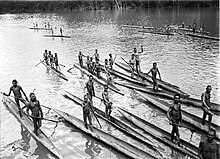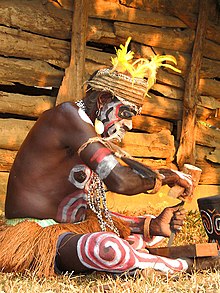Asmat
The Asmat ( people of the tree ) are an ethnic group with around 65,000 members (as of 1995) who inhabit an area the size of Belgium in the south of the Indonesian part of the island of New Guinea in the province of Papua . The Lorentz National Park protrudes into the area. Asmat is alluvial alluvial land, with a swampy, widely and deeply ramified river labyrinth and a good 200 kilometers long mangrove coast . In the west the area borders the Mimika , in the east the Sawi . In the north, the southern foot of the Maoke Mountains forms a locking bar.
geography

Agats is the most important and largest place in the Asmat area. The main means of transport over the rivers is the dugout canoe , external contacts take place via charter flights and very irregular shipping traffic over the Arafura Sea . Extensive mangrove forests can be found along the coast . When the tides change , the direction of flow of the rivers is reversed and brackish water penetrates up to 100 kilometers inland . The salt water advancing with the tide forms brackish swamps. Even further inland there are fresh water swamps.
Physique and language
The Asmat are of small stature, strong stature and have a light to dark brown skin color. Uniformly characteristic facial features are broad noses and frizzy hair.
There are five related Asmat languages, which in turn are divided into dialects and subdialects. The central Asmat or Bahasa Indonesia serve for comprehensive communication .
Nutrition and the environment
The Asmat live mainly from fishing (numerous species of fish, such as sawfish and catfish, crabs, shrimp and shellfish) and also from hunting . Crocodiles, water snakes, turtles and various sea and water birds are part of the menu. In the absence of stones and rocks in the region, the animals provide not only varied and protein-rich food, but also the raw materials for tools, equipment and jewelry. The increasing contact with the outside world since the end of the Second World War has also brought farm animals such as chickens and pigs to them. Horticulture has been practiced on a small scale since then. Their way of life is semi-nomadic , since more favorable sago reasons, war threats and other events lead to the resettlement of entire village communities. The landscape is increasingly changing from a brackish water to a fresh water swamp area, which reduces the biodiversity of the fish. The hunt for mammals is expanding. Wild boars, marsupials and flying foxes and typical land birds are increasingly being integrated into the food chain.
Another important supplier of food and raw materials is the sago palm . Your pulp is pounded and mixed with water to make a pulp, which is shaped into balls and roasted, then eaten. This diet is enriched by the protein-rich larvae of the Capricorn beetle , some of which are bred in the pulp of the sago palm and added to the sago pulp. For Nutzwerkzeuge are Nibung palm tree (grave sticks, sheets, arrowheads, spears), mangrove (timber and combat shields) and the nipa palm used (mats and elements for roof coverings). Lianas and rattan provide ties, wickerwork and bowstrings. Ax handles, blow horns and water containers are made from bamboo .
All resources decrease in the direction of the interior.
Clothing and jewelry
Asmat men's clothing is often limited to ritual body jewelry . Along the coast the men live naked. On festive occasions, the hornbill's upper beak adorns the male pub. Inland, the Asmat carry penis cases, which are increasingly emphasized in size the further west they live. These Phallocrypte are often made from fruit pods.
The Asmat warriors attracted attention with martial septum piercings , so-called "bipane". These were flat shell plates up to several centimeters wide, the shape of which is reminiscent of the guns of wild boars. A resin that is often fragrant was applied around the bridge in the nasal septum to make it comfortable to wear . Other Asmat jewelry for the strongly dilated or incised septum were made from pig bones, or sometimes from the shin of a killed enemy and were called "ooch" or "otsj". These could have a diameter of up to 25 millimeters.
Braided full-body masks are worn in a ritual in which the movement of the masks between the village and the forest is intended to strengthen the bond between the two rooms.
Ancestral cult
The ancestral spirits play an important role in the imagination and rite of the Asmat . They are reincarnated in the newborn children. The skulls of the ancestors are sometimes decorated and serve as everyday objects, for example as a headrest when sleeping. The skulls of killed enemies, on the other hand, are kept in the men's house. Whoever kills an enemy takes on their name and social responsibilities.
The material culture of the Asmat is characterized by elaborate carvings. Everyday and ritual objects are provided with ornaments. These include paddles, bumpers, shields and spears, but also canoes, which guide the souls of the deceased into the ocean, as well as ancestral stakes (see the ancestral stake festival ). The traditional art of carving now also produces handicrafts that are sold to the outside world. Barter takes place between communities .
society
The most important family group is a clan , which is grouped around a men's house (jeu) . This is where the men live after leaving their parents' house until their wedding. The Asmat marry outside of their group ( exogamy ). The marriages were once among the families of the future bride and groom arranged . Bride robbery , which often led to military conflicts, is a thing of the past , as is polygamy . Today monogamous marriages are entered into of their own free will.
Adoptions have the social task of relieving tension between clans. Instead of being adopted as a child, the child creeps through a symbolic birth between the legs of the adoptive mother and then receives a gift from his adoptive father.
While the external influence in the Dutch colonial era of Indonesia was limited to the establishment of mission stations , the Indonesian state tries to settle new settlers from other parts of the country in the Asmat area. Some of the traditional men's houses, which were the ritual represented the center, destroyed by meetinghouses replaced.
Festivals and beliefs of the Asmat
- Ancestral stake festival
- Mask festival
- Religion and philosophy among the Asmat people
- Asmat art and culture
Web links
- American Museum of Asmat Art
- The Chiaramonte Collection of Asmat Art
- Bibliography (English)
- Asmat Art Collection Gallery Berlin
literature
- Heinrich Harrer: Among Papuans. People and culture since their stone age. Innsbruck 1976 ISBN 3-596-23508-1 with several articles by Gunter Konrad
- Klaus Helfrich (Hrsg.): Asmat: Myth and art in life with the ancestors . Berlin 1995, ISBN 978-3-88609-381-6
- Gunter and Ursula Konrad (eds.): Asmat: Myths and Rituals - Inspiration of Art , Contribution: Klaus Helferich: The Asmat . Venice 1995, ISBN 88-7077-035-4
Individual evidence
- ^ Helferich, Die Asmat , p. 35
-
↑
Volume 2, contribution by Gunter Konrad and Yufentius Biakai: On the culture of Asmat: Mythe and Reality, p. 465–509
Mark Münzel : New Guinea use and interpretation of the environment . Ed .: Department for Culture and Leisure. tape 1 + 2 . Museum für Völkerkunde, Frankfurt 1987, ISBN 3-88270-360-1 , p. 725 . - ↑ Helferich, Die Asmat , p. 36
- ^ Helferich, Die Asmat , p. 37
- ↑ New Guinea shell septum
- ↑ The Septum Piercing
- ↑ Turkana tribe septum jewelry
